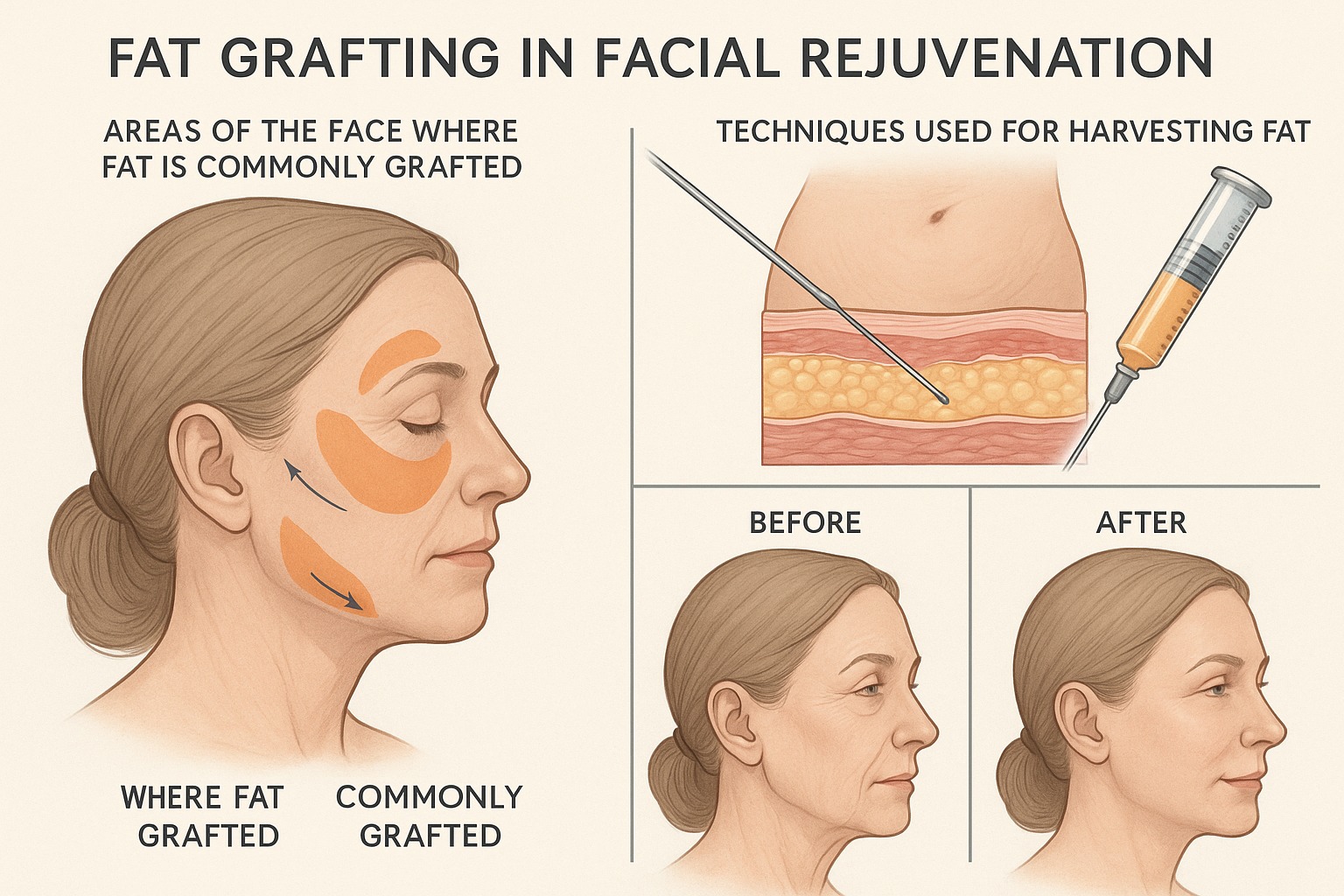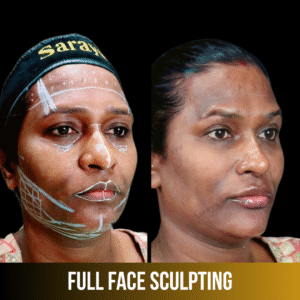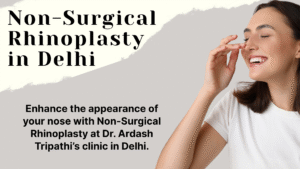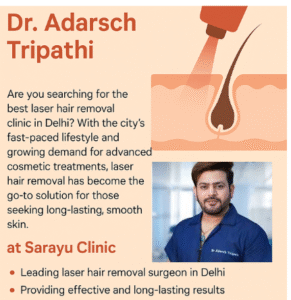Introduction
As we age, the loss of facial volume is a major contributor to a tired, aged appearance. While traditional facelifts lift sagging skin, restoring youthful fullness requires adding volume back—not just pulling tissues tight. Fat grafting (also called fat transfer or autologous fat injection) has become a cornerstone in modern facial rejuvenation, delivering natural, long-lasting volume restoration using the patient’s own body fat.

Dr. Adarsh Tripathi, expert maxillofacial and facial plastic surgeon in New Delhi, explains why fat grafting is safe, effective, and integral to contemporary aesthetic protocols for men and women aiming for durable, harmonious rejuvenation.
What Is Fat Grafting?
Fat grafting is a minimally invasive procedure that involves harvesting fat cells from one part of the body—usually the abdomen, flanks, or thighs—processing and purifying them, and then injecting these live fat cells into areas of the face where volume is lost. Because it uses the patient’s own tissue, fat grafting avoids risks linked with synthetic fillers, such as allergic reactions or rejection.
Common facial areas treated include:
- Cheeks (midface volume)
- Nasolabial folds (smile lines)
- Tear trough and under-eye hollows
- Temples
- Lips and perioral region
- Jawline and chin for contouring
Why Volume Loss Happens in Aging
- Fat pads deflate and shift downward with age, worsening jowling and hollow cheeks.
- Bone resorption reduces structural support for overlying tissues.
- Skin thins and loses elasticity, accentuating volume loss.
Fat grafting addresses this directly by replenishing lost fat compartments and lifting tissues subtly from within, producing a youthful, three-dimensional facial harmony.
Key Benefits of Fat Grafting
- Natural and Safe
Since the fat is autologous (from the patient’s own body), there is virtually no risk of allergic reaction or foreign body complications. The survival of transplanted fat is enhanced using advanced techniques in harvesting and processing. - Long-lasting or Permanent Volume Restoration
Unlike synthetic fillers that absorb over months, properly performed fat grafting can provide lasting volume that integrates with surrounding tissues. Although some fat may not survive the transfer, the retained fat (50–70%) generally lasts years or permanent. - Dual Benefit: Body Contouring and Face Rejuvenation
Harvested fat comes from areas where it may be surplus, like the abdomen or thighs, providing subtle body contouring along with facial volumization. - Versatile Restoration
Fat grafting can correct volume loss, asymmetry, contour irregularities, and scar depression, all in a single procedure. - Improvement in Skin Quality
Fat contains stem cells and growth factors that may improve skin texture and elasticity after transfer, offering regenerative benefits beyond volume replacement.
What Happens During A Fat Grafting Procedure?
- Consultation and Mapping
Dr. Tripathi assesses facial volume loss via clinical exam and imaging, designing a tailored plan considering facial proportions and aging patterns. - Fat Harvesting
Small, safe liposuction is performed under local anesthesia or sedation on donor areas (abdomen, flanks). Gentle technique preserves fat viability. - Processing
Extracted fat is purified to separate viable cells from oils and fluids, often using centrifugation or filtration. - Injection
Using fine cannulas, Dr. Tripathi strategically injects fat micro-droplets in layers into facial zones requiring volume restoration. This layering encourages fat survival and smooth contouring. - Post-Procedure
Minimal scarring at donor and injection sites; procedure typically lasts 1–2 hours.
Recovery and Results
- Downtime: Mild swelling, bruising at face and donor site for 1–2 weeks. Most patients resume work in 5–7 days.
- Pain: Generally mild discomfort managed by oral analgesics.
- Results: Progressive improvement as swelling resolves over 4–8 weeks. Initial volume is sometimes over-corrected anticipating some fat resorption.
- Longevity: Lasting results for several years; touch-ups optional based on patient goals and fat survival.
Who Should Consider Fat Grafting?
- Patients with midface or periorbital volume loss wanting natural correction
- Individuals looking for enhancement without foreign fillers
- Those wishing for a longer-lasting option combined with facelift or other rejuvenation
- Patients needing asymmetry correction or scar defect improvement
- Ideal for all skin types, including South Asian skin common in New Delhi and NCR
Fat Grafting vs Dermal Fillers
| Factor | Fat Grafting | Dermal Fillers |
| Source | Patient’s own fat | Synthetic (HA, CaHA, etc.) |
| Duration | Years (often permanent) | 6–18 months typically |
| Volume | Larger volumes feasible | Limited volume per session |
| Allergy Risk | Very low | Possible (rare) |
| Cost | Higher initial cost | Lower but recurring expense |
| Additional Benefit | Skin rejuvenation from stem cells | No regenerative effect |
Combining Fat Grafting with Facelift Surgery
Fat grafting enhances facelift results by restoring volume lost with aging, avoiding a “hollowed” look and providing a softer, natural rejuvenation. Dr. Tripathi often combines deep plane facelifts with fat grafting for complete structural and volume correction.
Safety and Risks
Fat grafting is very safe when performed by experienced surgeons, but potential risks include:
- Unevenness or lumps (can be remedied with minor corrections)
- Over or under-correction (addressed with follow-up treatments)
- Infection (very rare with sterile techniques)
- Fat necrosis or cyst formation (uncommon)
Preoperative health screening and adherence to post-op protocols minimize risks.
How to Prepare for Fat Grafting
- Avoid blood thinners and certain supplements 1-2 weeks before surgery
- Stop smoking and alcohol to promote healing
- Arrange for transportation and rest post-surgery
- Discuss all medications and medical history with your surgeon
Post-Procedure Care Tips
- Gentle facial cleansing; avoid pressure on grafted areas
- Use cold compresses first 48 hours to reduce swelling
- Follow dietary/sleep recommendations for optimal healing
- Attend all follow-up appointments for monitoring and advice
Why Choose Dr. Adarsh Tripathi for Fat Grafting in New Delhi?
- Expert training in facial volume restoration and maxillofacial surgery
- Personalized digital facial analysis for precise volume mapping
- State-of-the-art sterile surgical facilities in Greater Kailash‑1
- Patient safety emphasis and natural youthful aesthetics as priority
- Long-term patient support and comprehensive facial rejuvenation planning

Schedule Your Consultation
If volume loss is making you look tired or aged, fat grafting may offer a safe, natural, and long-lasting solution. Contact Dr. Adarsh Tripathi Clinic in New Delhi for a comprehensive assessment tailored to your unique facial structure and aging pattern.


